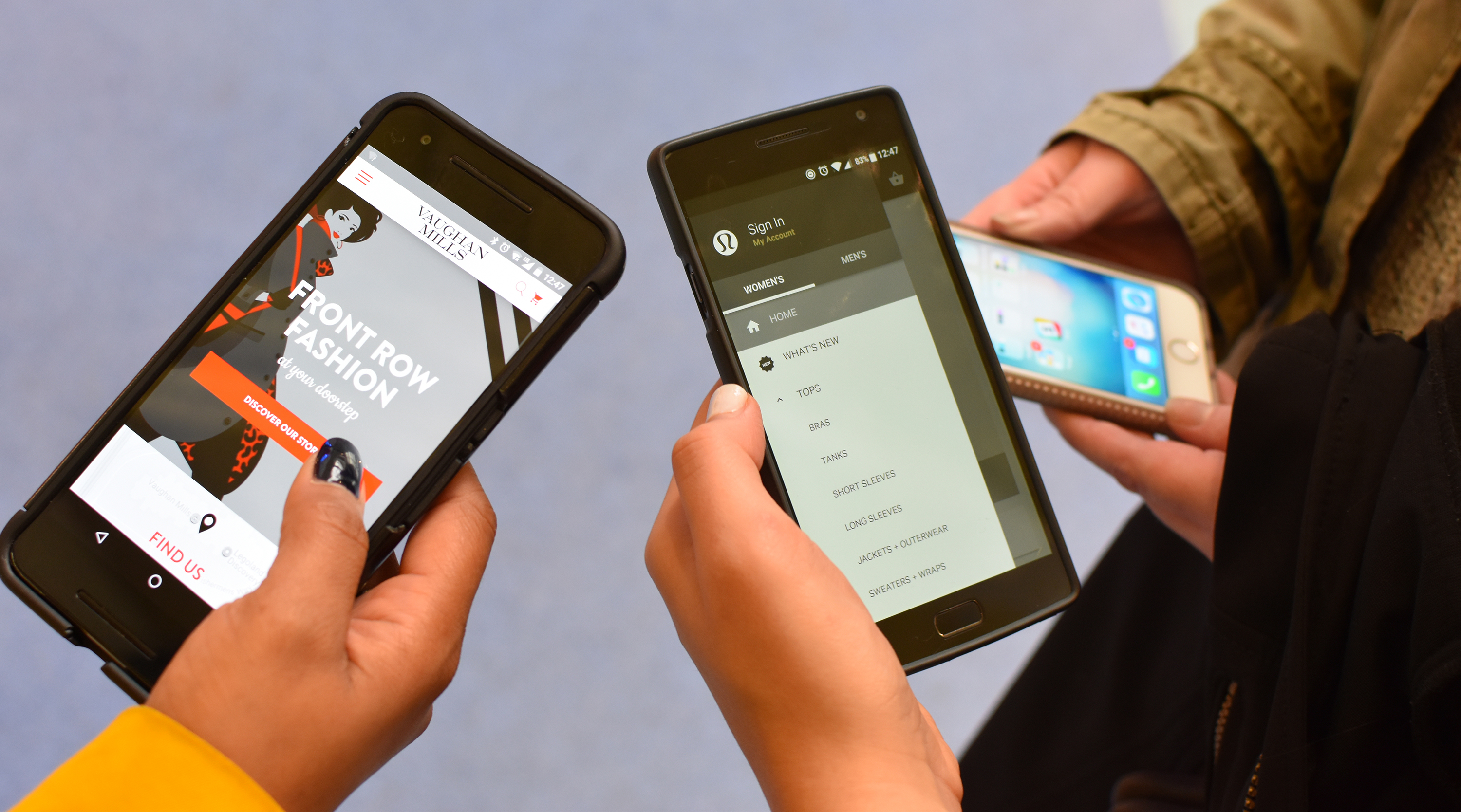E-commerce has been on the rise for a while, and although desktop purchases still prevail over mobile sales, advancements in mobile app development will encourage a surge in mobile commerce (or m-commerce) seniority.
The demand for mobile app development in retail is growing every year. More than ever, today’s retail landscape relies on a standard of immediacy. With people spending more time on their smartphones, retailers need to adapt to accommodate the universal shift towards mobile preference.
Branching out into the mobile app market is a win-win for retailers. Mobile apps provide retail brands a creative opportunity to give consumers the immediate, personalized shopping experience they prefer. At the same time, retailers can leverage mobile features and in-app analytics to attract, retain, and intuitively understand the purchasing behavior of their customers.
Your Customers Have New Shopping Patterns
The m-commerce approach to retail business shows no indication of slowing. In a survey conducted by Apptentive, 88% of respondents stated they used retail apps, and 61% of those using retail apps are active once a month.

By the end of 2016, m-commerce contributed $22.7 billion to online spending and accounted for nearly 21% of digital commerce revenue in the United States. In the years to come, the mobile percentage of online spending is anticipated to double to an estimated 45% of the U.S. e-commerce market.
Whether it makes sense to modify an existing e-commerce site to be mobile responsive or develop a brand new m-commerce app, it’s crucial for retailers to provide buyers with a more personalized shopping experience.
Is a Responsive Website Good Enough?
Making a mobile responsive e-commerce site can be a cost-effective way to put digital storefronts into the hands of consumers. Generally speaking, building a mobile responsive site is less time-consuming. However, users expect a level of quality and functionality that mobile sites sometimes can’t deliver.
Many retailers are still determining the best way to unify mobile experiences with their existing business strategies. A major area for improvement lies in alleviating the buyers’ frustration with mobile site navigation.
M-commerce enterprises fail to produce results when users are faced with performance and usability issues. Factors like load times, small images, lack of information, and network availability all present the same problem: users have to work way too hard to complete a purchase.
Today’s tech-centric consumer has revolutionized the value criteria for traditional retail, demanding more personal, consumer-conscious shopping experiences from retailers. Mobile apps are a lucrative resource for delivering the most appealing and functional, digital storefronts, and simultaneously serve as a measurement tool to track and improve online shopping conditions.
Recommended Reading: The Top Mobile Shopping Issues Your Customers are Facing
As m-commerce grows in popularity, it’s necessary for retailers to consider the profitability of mobile apps for business, and whether or not an app will add value to existing sales strategies. To help the decision-making process, here are 3 advantages of mobile apps that can augment e-commerce success.
Leveraging Device Features
Mobile apps one-up mobile sites through the integration of inbuilt smartphone components. Tapping into GPS features and camera access can dramatically enhance satisfaction by adding a convenience factor to the user’s shopping experience. Apple Pay and Android Pay extensions also complement the user experience by improving functionality.
Apptentive’s in-depth look at the mobile shopper determined that 71% of surveyed retail app users browse products through mobile apps and then make purchases in-store.

Considering this particular shopping pattern, GPS technologies are an advantage for retailers. With GPS, businesses can engage consumers and drive in-store sales with geofencing tactics. For example, an app can inform users about the nearest brick-and-mortar location based on their current position. Users can also receive location-specific information about sales and product availability. Retailers can get even more personal by sending tailored push notifications with offers and coupons when customers enter a physical location.
Mobile apps can also do some pretty amazing things with camera access. Augmented reality (AR) is taking the retail world by force with apps like Ikea Place, Sampler by Converse, Sephora Virtual Artist, and GAP’s DressingRoom. With AR, users can now preview how furniture will look in their home, determine what makeup matches their skin tone, and even see what outfit suits their body type.
Retail apps go way beyond product imagery neatly packaged in a mobile web container. When apps use smartphone features effectively they offer a unique and exclusive shopping experience. The truth is, consumers have access to an excessive amount of retail products, and with so many options, personalization is becoming a crucial differentiator among brands.
Personalized Shopping Experience
Data collection is intrinsic to the digital commerce ecosystem. Enter any digital commerce platform and the system can access user buying history, browsing patterns, demographic profiles, personal preferences among other identifiers. As technology progresses, data collection will dramatically improve the creation of individual-level portraits of purchasing behavior, resulting in enhanced, real-time responses to path-to-purchase fluctuations through personalization.
Artificial intelligence (AI) and machine learning (ML) are rapidly transforming the retail landscape in terms of data mining and personalized experience. These technologies capitalize on the consumer’s preference for intuitive experiences. Smart apps enable retailers with the technology to personalize products and inventory to a consumer’s changing preferences. Moreover, retailers can leverage contextual marketing tactics in a way that is both relevant and valuable to the consumer.
Recommended Reading: How Artificial Intelligence is Driving Mobile App Personalization
Case Study
The legendary fashion brand, Burberry, is quickly becoming a digital enterprise leader. The retail icon is an excellent example of how AI-infused mobile apps improve customer satisfaction, encourage brand affinity, and drive sales.
Burberry offers a number of loyalty and benefit programs that call for users to share profiling information, which the brand uses to offer recommendations and rewards. The app also links to users’ social media accounts to mine additional data concerning purchase trends and preferences.
Burberry’s investment in AI has rewarded them with a 50% increase in repeat customers.
Burberry has also created a strategic link between both online and offline retail landscapes with AI technology. Customers can use their smartphones to scan barcodes in-store and receive product information, manufacturing details and care instructions.
Moving forward, Burberry is focusing heavily on customer value management to consolidate its digital leadership in the industry.
Social Integrations

With more than 2.5 billion active social media users on mobile, social sharing is very effective for generating brand exposure. Social media installations are also proven to enhance app performance and functionality. Yes, you can link content to social media channels with a mobile site, but social media integration produces the best results when it’s inherent to an app’s configuration.
Apps that invite users to register with existing social media accounts dramatically improve the user experience. This feature simplifies the login process by eliminating tedious activation forms and reduces abandonment rates by giving users instant access to content.
This login method is paramount for retail app success. Most e-commerce environments allow users to add items to their cart before actually registering their information. However, a majority of mobile shoppers refuse to fill out an activation field to pay for items they’ve already selected for purchase. In-app social media extensions offer an uncomplicated registration process. A process that removes the purchase barriers users often face with mobile sites and improves the likelihood of a returning customer.
Another, more obvious, benefit of in-app social media installation is social sharing and its impact on exposure. Users can create and share wishlists, recommend products to friends, or post branded content they love across a number of social networks. With social sharing, products can reach a number of buyer segments that would otherwise have been neglected without this in-app feature.
Closing Thoughts
The truth is, shoppers are reluctant to support a brand with no digital presence, and mobile apps are rapidly becoming a deep-rooted part of the connected consumer’s life. The chances of building a loyal customer base are dramatically increased when shoppers are given the resources to interact with brands in a digital environment. To that end, a mobile strategy should be a high priority for retailers.





